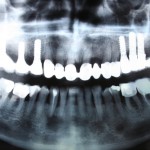
The use of dental implant to replace missing teeth is increasingly common and good survival rates are reported. When implants were initially introduced delayed loading was initially recommended. However, a number of studies and reviews have indicated that immediate or early loading also produces good survival rates.
The aim of this review was to compare the efficacy of immediate loading versus early or conventional loading implants in patients rehabilitated with fixed prostheses.
Methods
Searches were conducted in the Cochrane Central Register of Controlled Trials (CENTRAL), Medline/PubMed, and Embase databases with no restrictions. This was supplement with searches of the journals; British Journal of Oral and Maxillofacial Surgery, Clinical Implant Dentistry and Related Research, Clinical Oral Implants Research, European Journal of Oral Implantology, Implant Dentistry, The International Journal of Oral & Maxillofacial Implants, International Journal of Oral and Maxillofacial Surgery, International Journal of Periodontics and Restorative Dentistry, International Journal of Prosthodontics, Journal of Clinical Periodontology, Journal of Dental Implantology, Journal of Dental Research, Journal of Oral Implantology, Journal of Oral and Maxillofacial Surgery, Journal of Periodontology, Journal of Periodontal Research, Journal of Prosthetic Dentistry.
Two reviewers independently screened and selected studies and assessed risk of bias using the Cochrane tool. Randomised controlled trials (RCTs) with a least one implant with a fixed prosthesis comparing immediate, early of conventional loading with at least 15 patients were considered. Dichotomous variables were pooled as risk ratios (RR) and 95% confidence intervals (CIs) and continuous variables as weighted mean differences (WMDs) with 95%CIs.
Results
- 49 publications from 39 studies were included.
- Data from 1868 patients were pooled (914 in the test group and 954 in the control group).
- 3746 implants were inserted (1880 in test; 1866 in control)
- 6 studies were considered to be at low risk of bias, 8 at unclear risk the remainder at high risk.
- Implants as the statistical unit.
- Mean survival rate for immediate loading was 96.8% compared with 98.6% for delayed loading.
- Meta-analysis (20 studies) showed a statistically significant lower survival rate for immediately loaded implants RR = 0.974 (95%CI; 0.954 – 0.994).
- Patients as the statistical unit.
- Mean survival rate for immediate loading was 95.0% compared with 97.3% for delayed loading.
- Meta-analysis (19 studies) showed no statistically significant difference for lower survival rate between immediately and delayed loaded implants RR = 0.963 (95%CI; 0.927 – 1.001).
Conclusions
The authors concluded: –
Compared with early loading, immediate loading could achieve comparable implant survival rates and marginal bone level changes. Compared with conventional loading, immediate loading was associated with a higher incidence of implant failure.
Comments
The 2013 Cochrane review by Esposito et al (Dental Elf – 4th Apr 2013) looked at immediate versus delayed loading of implants finding no convincing evidence of clinically important differences linked with the different loading times and there have been a number of reviews since. The current review has undertaken a good unrestricted search of 3 major databases. 39 studies have been included compared with 26 included in the Cochrane review with 15 of these studies published since the Cochrane review. Fifteen of the studies are common to both reviews.
The poor quality of the included studies is a point highlighted by the authors of both reviews with this latest review highlighting the poor reporting of both random sequence generation and allocation concealment as well as a lack of blinded assessment. These issues should be noted when considering the findings of the review. In addition to the main outcomes reported (implant survival) in this review a number of subgroup analysis for other parameters were undertaken (healing method, implant time, occlusion, missing teeth, surgery guide, tooth position, surgery type, first restoration). While this provides some interesting data for discussion the number of studies contributing to these analysis is low so again they need careful consideration and interpretation.
Links
Primary Paper
Chen J, Cai M, Yang J, Aldhohrah T, Wang Y. Immediate versus early or conventional loading dental implants with fixed prostheses: A systematic review and meta-analysis of randomized controlled clinical trials. J Prosthet Dent. 2019 Aug 14. pii: S0022-3913(19)30343-9. doi:10.1016/j.prosdent.2019.05.013. [Epub ahead of print] Review. PubMed PMID: 31421892.
Other references
Dental Elf – 4th Apr 2013
No convincing evidence of a clinically important difference with different loading times of implants
Dental Elf – 23rd Jul 2013
Dental Elf – 3rd Mar 2015
